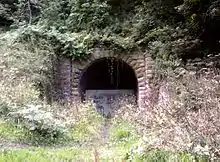Sandsend Tunnel
Sandsend Tunnel is a tunnel on the former Whitby, Redcar and Middlesbrough Union Railway that was opened in 1883 and closed in 1958. The rail line that ran through it was originally intended to travel along the top of the cliffs,[1][2] however some of the cliff fell into the sea whilst construction was suspended so the NER constructed two tunnels, the Sandsend Tunnel and the Kettleness Tunnel.

The Sandsend Tunnel is the longer of two tunnels being 1,652 yards (0.94 miles) in length. It is predominantly straight but the north-western 300 yards incorporate a curve to the north.
There are a total of five air shafts, two of which have nearby service galleries leading off horizontally to the cliffs which were used to dump spoil while carving out the tunnels, the air shafts were capped in 1958. The southern half of the tunnel is considerably damp with the tunnel being flooded to about 6 inches on the southern 300 yards. The southern portal of the Sandsend Tunnel is bricked up and it can only be accessed via the northern portal of the Kettleness Tunnel by walking through the Kettleness Tunnel and the area between the tunnels which is overgrown with grass and trees. The northern portal of the Sandsend Tunnel partially collapsed in 2008 after years of pressure from the cliff above.
References
- "Sandsend Tunnel". Retrieved 10 January 2011.
- Hoole, Ken (1986). The Whitby, Redcar and Middlesbrough Union Railway. Hendon Publishing Company. p. 21.
Further reading
| Wikimedia Commons has media related to Sandsend Tunnel. |
- Williams, Michael Aufrère (2010). 'A more spectacular example of a loss-making branch would be hard to find.' A financial history of the Whitby-Loftus line 1871-1958 (M.A. thesis). University of York.
- Williams, Michael Aufrère. (2012). The Whitby-Loftus Line. Jet Coast Development Trust. ISBN 978-0-9567890-1-3.
- Williams, Michael Aufrère (March 2013). "The Whitby - Loftus line: "a more spectacular example of a loss-making branch would be hard to find." Is this really the case?". Journal of the Railway and Canal Historical Society (216): 33–46.
- Williams, Michael Aufrère (November 2013). "The Viaducts and Tunnels of the Whitby-Loftus Line". Journal of the Railway and Canal Historical Society (218): 33–47.
- Williams, Michael Aufrère (January 2014). "The Tunnels and Viaducts of the Whitby-Loftus line". Forgotten Relics of an Enterprising Age.
- Williams, Michael Aufrère (March 2014). "A Difficult Year in the History of the Whitby, Redcar and Middlesbrough Union Railway". Journal of the Railway and Canal Historical Society (219): 32–41.
- Williams, Michael Aufrère (November 2014). "Closing a line before Beeching: the end of the Whitby-Loftus line". Journal of the Railway and Canal Historical Society (221): 149–58.
- Williams, Michael Aufrère (November 2015). "The importance of fieldwork in researching railway history". Journal of the Railway and Canal Historical Society (224): 377–87.
- Williams, Michael Aufrère (Summer 2016). "The Suez Specials". The Gresley Observer. The Gresley Society (169): 19–27.
- Williams, Michael Aufrère (Summer 2017). "How the Coast Line could have been saved". The Gresley Observer. The Gresley Society (172): 32–33.
- Williams, Michael Aufrère (November 2018). "The costs of working a failing branch line: a financial study of the Whitby – Loftus line, 1910–1933". Journal of the Railway and Canal Historical Society (233): 351–62.